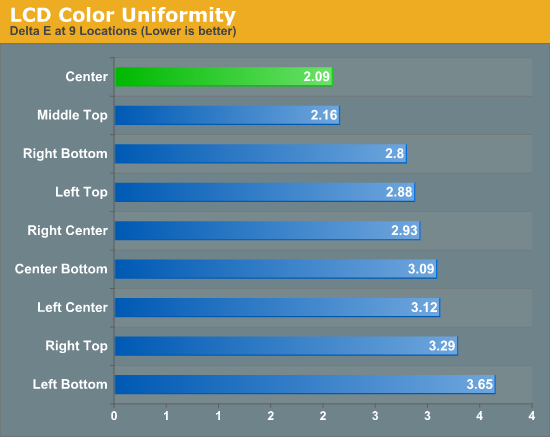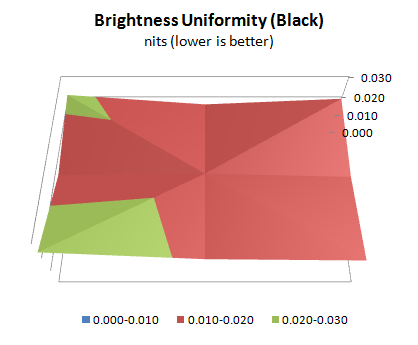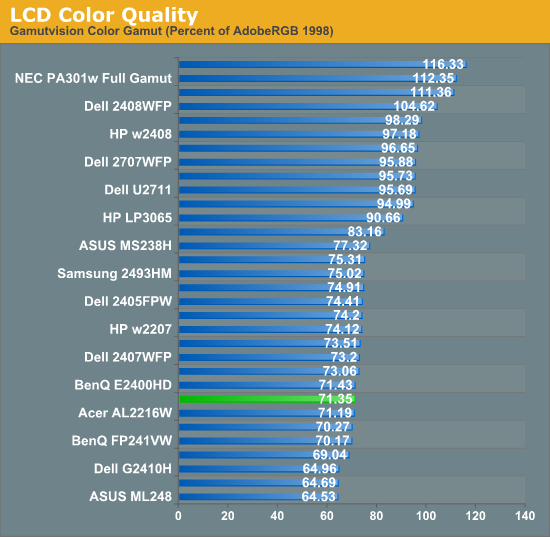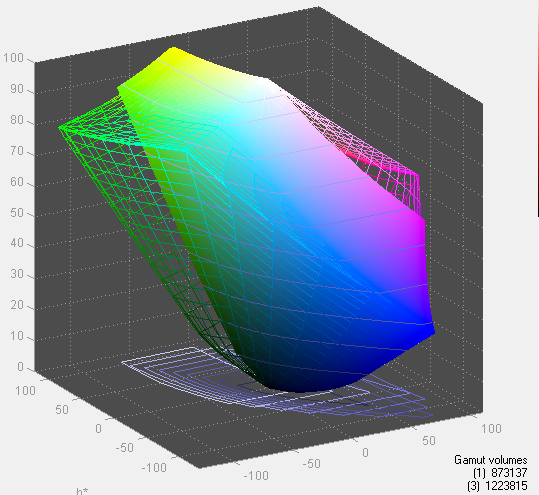BenQ VW2420H Monitor Review
by Chris Heinonen on December 10, 2011 2:45 AM ESTUniformity and Gamut
When we looked at the color on the VW2420H, the dE number for the very center of the panel at 200 nits of brightness was pretty decent at right around 2.0. Unfortunately it seems that the center of the panel performs better than the rest of the panel as a whole. The center and top-middle of the display are right around 2.0 for their average dE, but the rest of the panel is closer to 3.0 or higher. For this reason if you are doing color sensitive work, you probably want to keep what you are working on in the center of the screen and use the edges of the screen for other things.


When I looked at the raw data for the uniformity values, aside from the center point the white values were much worse across the display. When we look at the brightness uniformity we can clearly see why that is. While it is a bit odd that the bottom-middle has the 2nd most accurate brightless level but the top-middle has the 2nd most accurate color dE, overall you can see the correlation between dE and brightness uniformity. As the light level changes, the color accuracy of white and everything else drifts from the calibrated values. This uniformity issue will exist with almost any panel using conventional lighting techniques.

The black level uniformity is a little bit better than the white uniformity, but since this doesn’t have the same level of effect on dE levels that white uniformity does, we are less concerned with it. The higher numbers in the corners could be due to light leakage around the edges of the display, which often happens, but the standard deviation for all the measurements is just 0.002 nits, so I’m not concerned with this at all.

The BenQ offers up a gamut that is in the sRGB colorspace and testing bore that out, showing that is occupies just over 71% of the Adobe RGB gamut as we would expect. There's nothing really surprising or different here, as if you want the full Adobe RGB gamut you’ll need to look for a different backlighting system.












48 Comments
View All Comments
blueeyesm - Saturday, December 10, 2011 - link
"When initially hooked up and set to 200 nits of light output, the average dE of the BenQ is in the single digits, which unfortunately is very good for a consumer class LCD monitor."I think you may have meant "is not very good..."
Ryan Smith - Saturday, December 10, 2011 - link
Close. That was supposed to be "high single digits". Which actually is fairly good for a consumer LCD. It's only the professional LCDs that have good-to-decent accuracy out of the box.Samus - Saturday, December 10, 2011 - link
the last benq monitor i bought had an external power supply that failed twice before i finally ebay'd the monitor. as a credit to benq (a company with traditionally bad rap for support) they did replace the power supply both times, the second time being out of warranty! but the power supply ran super hot, and the monitor drew 160 watts from the wall when measured with a kill-a-watt.hopefully they've changed 'wall-wart' manufactures.
Rolphus - Sunday, December 11, 2011 - link
I've found BenQ's support to be excellent. I have an XL2410T that had a manufacturing defect (really bad light bleed on the right hand side), and getting it swapped out was extremely easy. I've also got a BenQ FP241W I use for work, and that has been very reliable, and with excellent picture quality.Neither of them use wall-warts for power: perhaps it's a component supply issue.
cheinonen - Sunday, December 11, 2011 - link
I will go clear that up, but yes, for a consumer display straight out of the box, anything below double digits is unfortunately considered to be good. The consumer video realm is finally getting to where displays and projectors have modes that are reasonably (dE < 5) accurate out of the box, so hopefully PC displays will get there as well.joelypolly - Saturday, December 10, 2011 - link
Lack of VESA mounts means that even though this is a pretty nice monitor it means that I won't be buying itMakaveli - Sunday, December 11, 2011 - link
"The main negatives for the BenQ in my book are the total lack of adjustments beyond tilt, which you can’t remedy with a different stand due to the lack of VESA mounting holes, and the OSD interface."Ditto for me also this would be a no buy just for this fact.
Goodjob Benq thanks for coming out.
psychobriggsy - Tuesday, December 13, 2011 - link
I've had this monitor for over a year now. Maybe it has just hit the US? I paid around £170 a year ago.It's extremely thin - which the review doesn't mention - and it uses a wall wart because of this.
It's a shame they didn't built the power supply and signal inputs into the base, as that would have been very tidy, instead cables hang out the back of the monitor (like any other) which rather lets down the point of creating a 'stylist monitor' in the first place, and losing VESA mounts, etc.
The picture quality is very good, for a consumer monitor, and far better than TN monitors in my opinion. Of course for serious gaming the TN monitors do have the fastest response times and the 3D options.
Torrijos - Saturday, December 10, 2011 - link
Black shiny edges are horrible for me...They reflect the light fixture directly into your eyes, incredibly annoying, I had to put tape on my last screen avoid the strain.
When are manufacturers going to understand buyers don't care about shiny just about functionality.
toyota - Saturday, December 10, 2011 - link
yeah bright shiny bezels are asinine for a monitor because they reflect everything around you. even the screen gets reflected on the inside edges of the bezel and that drives me nuts when playing a game or a movie.